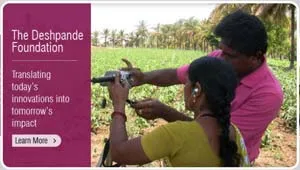Gururaj Deshpande explains how his Sandbox model works tocreateSocial Innovation

Question: Will the sandbox support just the non-profits or will it also support the for-profits?Gururaj Deshpande: In a lot of ways, I don’t really see a lot of difference between a for-profit and a non-profit business, because, even when a for-profit entrepreneur starts something, he’s trying to come up with a product or service that makes the world a better place. So, you can also introduce social interventions that will help the underprivileged by making them into a for-profit model. So, we’re very committed to a for-profit too. In fact, I like those systems better. For example, we’re working with an organization called H2O, which is a technology that can crank out a thousand liters of clean water, for very little money. And so, this organization, which has come up with a machine that sells for about INR 4 lakhs, would be sold to an entrepreneur in a village and that entrepreneur would actually supply clean water to the whole village. It’s a self-sustaining model where he actually makes money. And so, I am a big believer in setting up social interventions that can be profitable because they can be sustainable. They may need some investment to actually debug the model, but those are very good. But, there are interventions where you cannot turn them into for-profit. For example, Akshaya Patra, where you feed mid-day meal to the school children, you cannot charge the children for the mid-day meal and therefore those things have to be part of a government-supported program, as well as a very broad-based charity.

Question: In the US, you are supporting technology innovation at the MIT and in India, you are doing social innovation. Will Deshpande Foundation support technology innovation in India and social innovation in the US?So, we actually have a sandbox that we just set up to do social innovation in the US because the social innovation sandbox is as relevant in the US as it is in India. Similarly, what we’re doing for technological innovation is that we see an interest from a number of universities that want to set up a Deshpande Centre for Technological Innovation. Obviously, our foundation is not big enough to start a centre in every university, so we have actually created a Deshpande Innovation Network. We’re working with about 25 universities and I’m hoping that a lot of the universities in India will join this network, so that all of them together can find a methodology to connect innovation to relevance so that any innovation in the network will have a bigger impact economically and socially.
Question: How does the ecosystem help an entrepreneur?
Well, you know the entrepreneurial system is when you could always have an entrepreneur pop up in a place and fight against all odds and make things happen. What the ecosystem does is it reduces the friction for an entrepreneur to achieve his dreams. So, you’ll have other entrepreneurs who have gone through the system. You need a whole bunch of skills to be an entrepreneur, and so you’ll have people who can teach you those skills and people who have gone through that path. Every entrepreneurial journey is a unique journey. Just because somebody has done it before doesn’t mean that it’s going to be easy for the next entrepreneur. But if somebody has already been to the Himalayas, he sharing his stories of what happened and what did he pack to actually make the journey is very helpful for the next person who goes to the Himalayas. So, the ecosystem is all about reducing the friction and making it easier for entrepreneurs to realize their dreams.
Question: Any future plans for the Sandbox or the Deshpande Foundation that you would want to share?

I think people within India should actually look at the sandbox model in depth. Because in India, there are a lot of entrepreneurs who have been very successful, created a lot of wealth, and they’re looking for ways to use their innovation entrepreneurship to create a social change. And so this model involves investing in an ecosystem and creating a playground where a lot of people can juggle around so that you can experiment and come with interventions that are very meaningful. For India, we need low-cost interventions that can scale to millions. This is a model that I think is very unique. We started this experiment in India for the very first time in the world and now it’s getting a lot of visibility. In fact, the Harvard Business School (HBS) has written a case study on the sandbox. I and my wife, Jayshree, actually went and taught about 900 first-year MBA students of HBS about the sandbox model. You never know for another 15–20 years whether it really works or doesn’t work, but my gut feel is that it’s a good model, and I’m very pleased with the investment that we’ve made and the results we’ve achieved. And, so, I would love to see other successful entrepreneurs who have the means and the DNA to actually support these kinds of sandboxes to come forward and support a lot other sandboxes in their own way.Website: http://www.deshpandefoundation.org/







